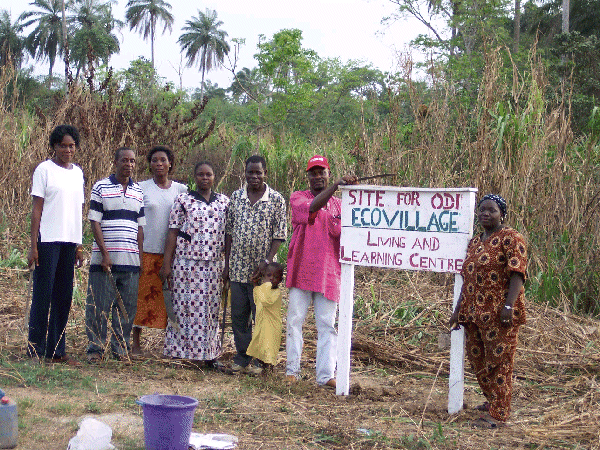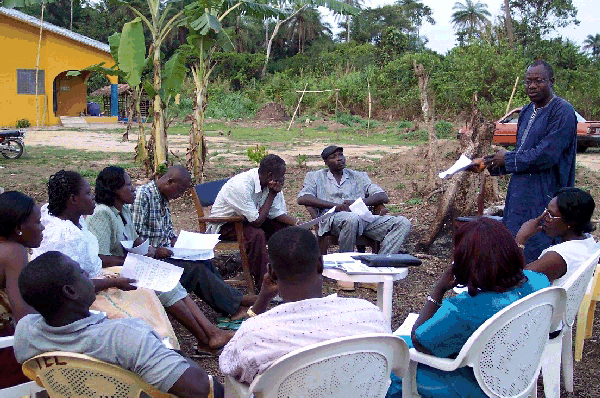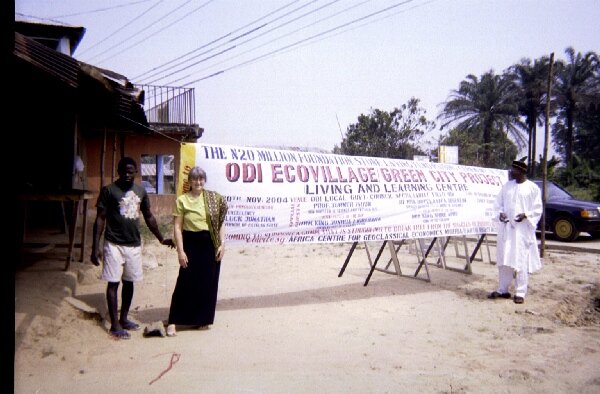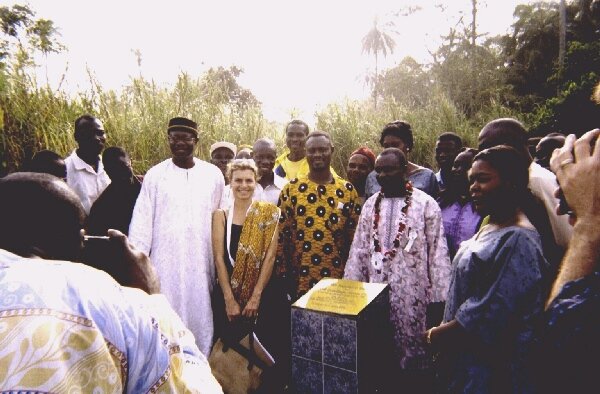 |
|||||||
Eco-Plan for ODI in Nigeria
Report & Photos: Francis Udisi and Gordon Abiama in Bayelsa State, June 2007 Co-Directors Nov/Dec 2004 Odi Ecovillage visit photo tour Odi Ecovillage Brochure (371K PDF file) 14 Days in Bayelsa State, Nigeria, 2004 - Alanna Hartzok Jonathan Dawson, who has worked in Africa for many years as a UN consultant and resides in Findhorn, Scotland, gave a wonderful report about the 2004 launching ceremony for Odi Ecovillage and Green City. Spring 2005 Friends of Nigeria Newsletter Hartzok Received Council of Peers Award for Excellence in Oral Public Communication and Leadership |
With the 21st century, comes the fundamental challenge facing every society to create political, economic and social systems that promote peace, human welfare and the sustainability of the environment on which life depends. This project is to serve a specific region that has been classified as an area in need from the recovery from the devastation by war, ecological catastrophe, economic collapse and significant political instability.
INTRODUCTION
Odi, a village on the Nun River in Bayelsa State of the Niger delta area in the federal republic of Nigeria had a pre-1999 population of 60,000 people as the second largest town in the state. It had boast of being the largest number of most educated people in the region. Unfortunately, in the late 1999, a massive brigade of Nigerian army invaded this historic town with a mandate to fish out local bandits for a national crime. Tragically, Odi was completely wiped out in less than a day save three buildings--a church, a bank and a public health center.
Today, Odi remains underdeveloped, impoverish, highly and grossly unplanned. It is a region that is in desperate need of recovery.
VISION
Our vision is to implement an eco-development and eco-restoration plan for the village of ODI by making it a role model for change that helps eradicate poverty, reduce disparities in living conditions and manage development and the environment in a balanced and sustained manner.
GOAL
The goal is to develop a new model of design, restoration and urban planning called ‘The Green City Program’ for Odi that would in its first phase adequately provide a minimum of 5,000 households affordable housing, over a five year period. Eventually, it is the hope that this plan would continue for the remaining 55,000 homeless residents of the village in the future.
What does it mean the Eco-restoration of Odi?
Through using new knowledge and applications, this program will bring together local authorities and other necessary groups to engage in the process of defining how these new public policies and new innovated ideas can bring about equitable development and create healthy communities for the region. An eco-restoration will knit together the natural systems with the needs of the local population.
The first phase of this program would be to create a think-tank group of ecological planners with other partners from the area to develop the first eco-restoration plan for ODI. This feasibility project would draw up a map for the future planning and restoration of Odi based on a similar blueprint of an ecovillage system. The team would bring in the proper materials and skilled persons to provide public education for the local citizens and policy makers to eventually become sustainable partners for the implementation of a ‘Green City’ for Odi. Some of these resources would include the development of a media campaign, educational manuals and a Web site.
The applications for developing an Ecovillage system would take into consideration the traditional town planning, the basic traditional cultural values and then integrate this with new green innovated ideas. It includes addressing the local health of ecosystems and of the populations together. This project would demonstrate how a team of dedicated skilled persons can go beyond the jurisdictional constraints of public planning agencies in a fragmented village, using the latest planning and communications technologies, and lead a citizen-based discussion about more sustainable patterns of settlement. Ultimately, sustainable development must not only involve what governments can do, but it is imperative for people to achieve themselves through individual and collective change.
There is urgency to create a plan for the restoration and re-development of Odi. Presently, though there is a slow growth in population and employment, the consuming habits of the local people are in need of more land per person. As a result, present practices are creating negative impacts on to the region by spreading out the assets, undermining the health of existing family lands, destroying valuable farmland and open space, and creating intractable environmental problems. With such a program for Odi, we know that this Eco Plan will address these immediate concerns and bring about the objectives to evolve Odi from its current tragic state into a new ‘Green City’ model that ensures a healthy economic, environmental and social community for all.
Below are some of the areas the Eco Plan for Odi will address:
TRANSPORTATION SYSTEM
EROSION THREATS
RENEWABLE ENERGY
SUSTAINABLE WATER SUPPLY SYSTEM
ECOVILLAGE TOURISM
PERMACULTURE AND REGENERATIVE AGRICULTURE
TELEVISION AND INTERNET CENTERS
MICRO-FINANCE AND INDUSTRIES GENDER EQUALITY
HIV/AIDS INFORMATION CENTER
PHYSICAL IMPROVEMENTS
For further details of each category is available upon request.
CONCLUSION
The eco-restoration project of Odi has plans to be a landmark achievement that will demonstrate the ability of will and sense of purpose to the execution of an activity that will not only become a pilot program for the state but to the entire nation of Nigeria. It will demonstrate the practical use of local building material to build a modern livable city with the judicious employment of resources.
We hope to be given the chance to show how “The Green City Program” will boast of decent housing but allow for a natural regeneration of the environment that has been destroyed by both man and natural disasters, thereby, constituting it as a TOURIST and INDUSTRIAL center of the region that will generate revenue for its maintenance and encourage the establishment of cottage industries that will boast employment and conflict reduction in the region.
EVALUATION
Evaluation methods would be instituted and implemented to monitor and gauge the progress and the achievement to maintain the set goals and objectives. This will be done on a quarterly basis.
BUDGET
An estimated budget of $US 1,000,000.00 per year for the next five years could meet the desired goals and objectives of affordable housing for the homeless population and complete an Eco Plan for Odi.
ADMINISTRATIVE STAFF
The following are the initial administrative staff:
Alanna Hartzok, co-Director of Earth Rights Institute
Annie Goeke, co-Director of Earth Rights Institute
Gordon Abiama, Director of the Africa Center for Geoclassical Economics
Francis Kabiowei Udisi, Project Coordinator for Eco-Restoration of ODI
Sunny Akoupho, Renewable Energy Advisor
Patrick Osta Udisi, Resident Local Co-coordinator
Jonathan Dawson, Technical Consultant from GEN Europe Group
Paul Metz, Technical Consultant from Intergerconsult Organization
Solomon Ebi Apreala, State Government Representative
Dr. Emmanuel Denenu, ODI village Representative



Odi Ecovillage Launching Event with Alanna Hartzok

Odi Ecovillage Groundbreaking Ceremony with Annie Goeke
http://www.earthrights.net/ecovillages/odi/